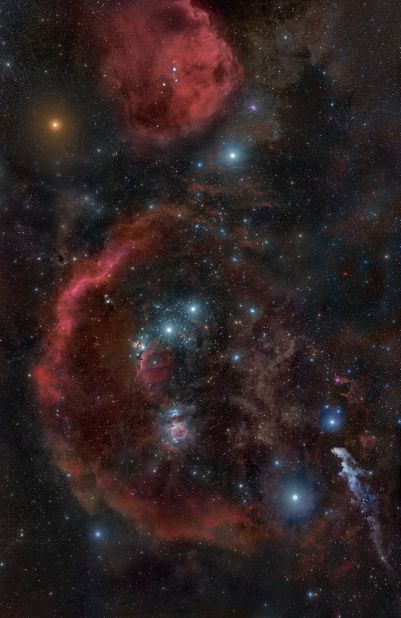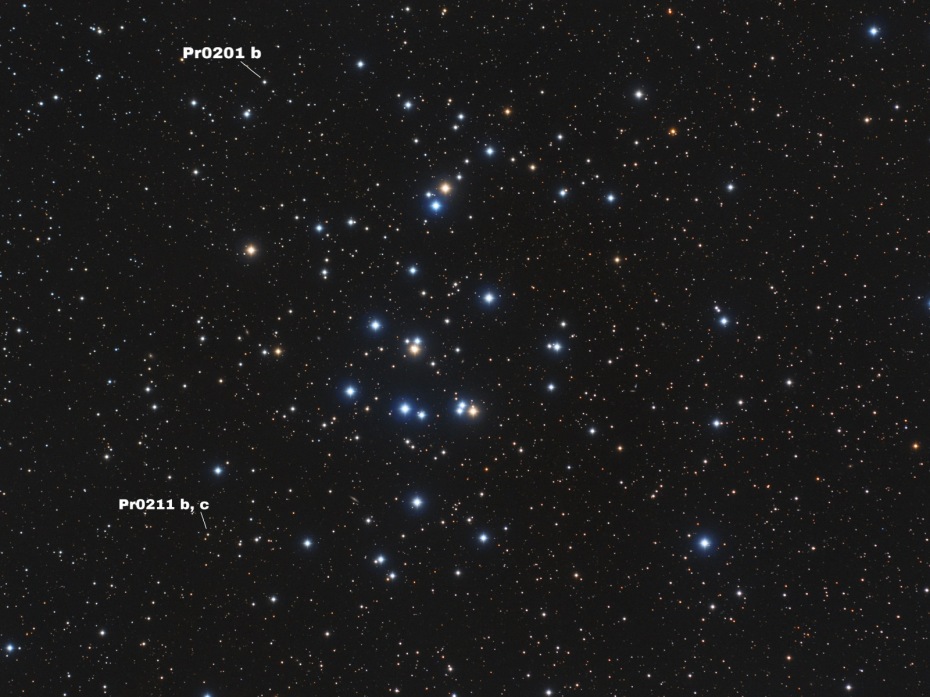An open cluster spanning some 15 light-years, M44 holds 1,000 stars or so. The cluster was not resolved into its individual stars until telescopes were available (Galileo was first to resolve its stars). A popular target for modern, binocular-equipped sky gazers, the cluster’s few yellowish tinted, cool, red giants are scattered through the field of its brighter hot blue main sequence stars in this colorful stellar cover image.
Introduction
The Beehive Cluster, M44, is an open cluster in the constellation Cancer. It is one of the nearest open clusters to Earth, containing a larger population of stars than other nearby bright open clusters. Under dark skies, the Beehive Cluster looks like a small nebulous object to the naked eye; as known since ancient times. And it was among the first objects that Galileo studied with his telescope.
Beehive Cluster also contains red giants and white dwarfs, which represent later stages of stellar evolution, along with many main sequence stars.
Mass segregation is seen in this cluster, as is common in these types of clusters, i.e. heavier stars sank towards the center and lighter stars are left behind on the outer region.
Observation
the Beehive is easily visible to the naked eye as a small nebulous cloud when Cancer culminates in the early evening sky each year from February to May. At 1.5° across, the cluster easily fits within the field of view of binoculars or low-powered small telescopes.
A mere 600 light-years away, the Beehive cluster, its stars are young though, about 600 million years old. If you compare it to the age of our Earth, i.e. 4.5 billion years, Beehive cluster really is a spring chicken in astronomy terms. Based on similar ages and motion through space, M44 and the even closer Hyades star cluster in Taurus are thought to have been born together in the same large molecular cloud.

Image Source: Wikipedia
Note: You can see a hint of molecular cloud around Orion constellation in long exposure shots from an entry-level DSLR.
The Beehive’s 1,000 stars
There are approximately 1,000 stars in the beautiful Beehive Cluster, which is an open cluster of stars in our galaxy. Open clusters are stars that are gravitationally bound and are created out of the same star-forming nebulae, such as the stars in the Orion Nebula. It has a larger population of stars than most other nearby clusters.
Myths and History
As early as the second century A.D., Ptolemy wrote that the Beehive star cluster was:
… the nebulous mass in the breast of Cancer.
In ancient times, the cluster was used as a weather predictor. Pliny said:
If Praesaepe is not visible in a clear sky it is a presage of a violent storm.
Early Observations
In 1609, Galileo first telescopically observed the Beehive and was able to resolve it into 40 stars. Charles Messier added it to his famous catalog in 1769 after precisely measuring its position in the sky. Wilhelm Schur, as director of the Göttingen Observatory, drew a map of the cluster in 1894.
Around 1769, Charles Messier added the cluster to his famous catalog of nebulous objects. Hence the designation M44: the 44th object in Messier’s catalog.
Discovery of Planets

In September 2012 two planets which orbit separate stars were discovered in the Beehive Cluster. The finding was significant for being the first planets detected orbiting stars like Earth’s Sun that were situated in stellar clusters. Planets had previously been detected in such clusters, but not orbiting stars like the Sun. The planets have been designated Pr0201 b and Pr0211 b. The ‘b’ at the end of their names indicates that the bodies are planets. The discoveries are what have been termed Hot Jupiters, massive gas giants that, unlike the planet Jupiter, orbit very close to their parent stars. In 2016 additional observations concluded that in the Pr0211 system there are actually two planets, the second one being Pr0211 c.
How to spot it in the night sky?
On a winter night, look for Sirius, the brightest star in the sky (south). Now look for a red faint star (Betelgeuse) to the north-west/right of Sirius (almost 15 degrees away). Now make an equilateral triangle with these two stars and a relatively bright star above/left of these two, this is Procyon. Join Sirius and Procyon and extend the line further after Procyon – at about half, the distance as between Sirius and Procyon is the Beehive Cluster – appears like a blob of light to naked eyes. Appears like a dense cluster of dimly lit stars against a patch with a 10x50mm binoculars.
~AK
Source : Wikipedia
